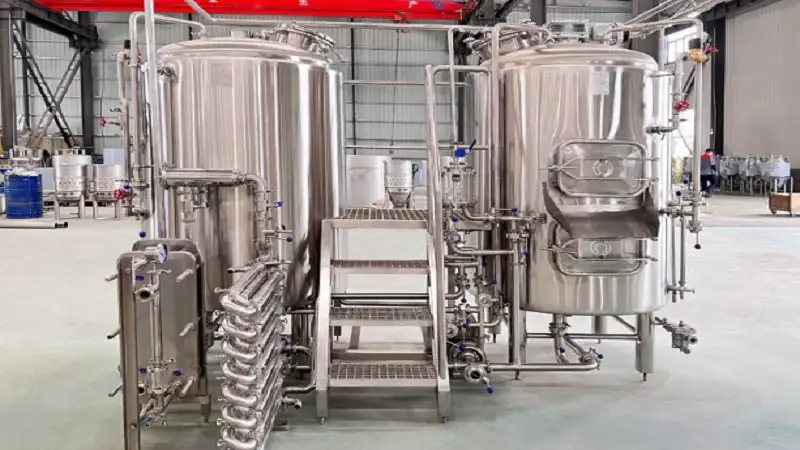The beer industry has evolved from small local operations into a global network of large breweries producing millions of barrels annually. While microbreweries and craft beer startups often get much of the attention, large-scale breweries remain the backbone of the industry, meeting mass demand with efficiency and consistency. At the heart of these operations lies industrial brewing equipment, purpose-built to handle massive production volumes while maintaining product quality.
This article explores the essential components of industrial brewing equipment, the technology driving efficiency, sustainability innovations, and the challenges of operating at scale.
The Scale of Industrial Brewing
Large breweries typically produce hundreds of thousands to millions of barrels per year. Meeting this demand requires highly specialized equipment designed to handle continuous production, rigorous quality control, and complex logistics. Unlike smaller systems, industrial equipment is engineered for durability, automation, and integration across multiple stages of the brewing process.
The scale alone influences equipment design: tanks that hold hundreds of barrels, automated packaging lines that process thousands of cans per hour, and integrated systems for energy recovery and waste management. These investments ensure large breweries remain competitive in a global market.
Key Components of Industrial Brewing Equipment
1. Brewhouse Systems
The brewhouse is the center of any brewery, where raw materials are transformed into wort. Industrial-scale brewhouses often include:
- Mash tuns with automated temperature and stirring systems
- Lauter tuns designed for fast, efficient wort separation
- Brew kettles and whirlpools with precise heating and automated wort clarification
- Advanced automation for recipe consistency and efficiency
Brewhouses in large breweries can reach capacities of 100 barrels or more per batch, designed for continuous operation.
2. Fermentation and Conditioning Tanks
Large breweries rely on massive cylindroconical fermenters (CCVs), often towering several stories high. These tanks are engineered for:
- High-volume fermentation
- Cooling jackets for precise temperature control
- Pressure resistance for carbonation management
- Automated cleaning systems (CIP)
Conditioning or maturation tanks are equally critical, ensuring beer develops its intended flavor and clarity before packaging.
3. Filtration and Clarification Systems
For mass-market beer, clarity and consistency are paramount. Industrial breweries invest heavily in:
- Crossflow filtration for efficient yeast and protein removal
- Centrifuge systems to accelerate clarification
- Diatomaceous earth (DE) filters for polishing
These systems guarantee the product meets strict quality and appearance standards.
4. Packaging Equipment
Packaging is often the most complex and costly aspect of industrial brewing equipment. Large breweries must meet diverse packaging demands—cans, bottles, and kegs—at lightning speed.
- High-speed bottling lines capable of 50,000+ bottles per hour
- Automated canning systems with integrated seaming and labeling
- Kegging lines with washing, filling, and stacking automation
Packaging lines often integrate with palletizing and logistics systems, minimizing labor requirements and maximizing efficiency.
5. Utility and Support Systems
Behind the scenes, industrial brewing equipment requires robust support systems:
- Glycol chilling plants to regulate fermentation temperatures across massive tanks
- Steam boilers for brewhouse heating
- Compressed air systems for packaging automation
- CO₂ recovery units to reuse fermentation gas
These utilities are vital to maintaining consistent production on a large scale.
Automation in Industrial Brewing
One defining feature of industrial brewing equipment is the level of automation. At scale, manual brewing is impractical, so breweries rely on advanced software and control systems:
- SCADA (Supervisory Control and Data Acquisition) systems monitor and control the brewing process in real-time.
- Recipe management software ensures precise ingredient additions and repeatability.
- Remote monitoring allows operators to oversee processes from centralized control rooms.
Automation reduces labor needs, minimizes human error, and enhances consistency, which is crucial for large breweries selling to global markets.
Sustainability in Industrial Brewing Equipment
With great scale comes great responsibility, and sustainability has become a major focus in industrial brewing equipment design. Breweries are adopting systems that reduce energy, water, and waste.
Energy Efficiency
- Heat recovery systems capture energy from boiling wort and reuse it for preheating.
- Insulated tanks minimize heat loss.
- Renewable energy integration, such as solar or biogas, supports brewing operations.
Water Conservation
- Modern CIP systems reduce water use by recycling cleaning fluids.
- Filtration systems reclaim water for non-production uses.
- Water-to-beer ratios as low as 3:1 are now achievable in advanced facilities.
Waste Management
- CO₂ recovery systems reduce greenhouse gas emissions.
- Spent grain is repurposed as animal feed or biofuel.
- Anaerobic digesters convert waste into renewable energy.
Large breweries that invest in sustainability not only reduce their environmental footprint but also save millions in operating costs over time.
Customization and Flexibility at Scale
While industrial brewing focuses on efficiency, flexibility remains important. Consumer tastes evolve quickly, and breweries must adapt. Equipment manufacturers now design systems that allow:
- Rapid changeovers between beer styles
- Parallel brewing lines for experimentation
- Modular expansions for growing capacity
This flexibility enables large breweries to keep up with the craft movement, producing seasonal or specialty beers without disrupting mass production.
Choosing an Equipment Supplier for Large Breweries
Industrial brewing equipment represents multimillion-dollar investments. Choosing the right supplier is critical. Breweries should evaluate suppliers based on:
- Proven experience with large-scale projects
- Engineering and installation support
- Customization and scalability options
- After-sales service and spare parts availability
- Commitment to sustainability practices
Global suppliers like Micet Craft have become trusted partners for breweries worldwide, offering complete turnkey solutions tailored to large-scale operations.
Challenges in Industrial Brewing Equipment
Even with advanced technology, large breweries face challenges:
- High upfront costs: Equipment investments can exceed tens of millions.
- Maintenance complexity: Specialized staff are required for operation and repair.
- Regulatory compliance: Meeting global food and safety standards is non-negotiable.
- Supply chain management: Coordinating raw materials and packaging on a massive scale requires integration with equipment systems.
Navigating these challenges requires careful planning and strong supplier relationships.
Future Trends in Industrial Brewing Equipment
Looking ahead, industrial brewing equipment will continue to evolve with technological and market shifts. Key trends include:
- Greater integration of AI and predictive analytics for process optimization.
- Smarter automation with machine learning to adjust brewing in real-time.
- Expanded focus on circular economy principles, where waste streams are fully repurposed.
- Increased investment in flexible packaging lines to meet consumer demand for diverse formats.
- Wider adoption of digital twins to simulate and optimize brewery operations before physical implementation.
These innovations will further enhance efficiency, sustainability, and profitability for large breweries.
Conclusion
Industrial brewing equipment is the foundation of large-scale beer production, combining engineering precision with advanced automation and sustainability features. From massive brewhouses and fermenters to high-speed packaging lines and utility systems, every component is designed for efficiency and consistency at scale.
As consumer preferences evolve and environmental pressures grow, breweries are investing in equipment that balances volume, quality, and sustainability. By choosing the right equipment suppliers and embracing new technologies, large breweries can remain competitive while shaping a more sustainable future for the industry.
FAQs
1. What is the typical cost of industrial brewing equipment for a large brewery?
The cost varies depending on capacity and automation, but full-scale industrial setups often range from $5 million to over $20 million. Packaging lines and utility systems are typically the most expensive components.
2. How long does it take to install industrial brewing equipment?
Installation and commissioning can take anywhere from six months to two years, depending on the scale of the project and whether it involves new construction or expansion of existing facilities.
3. Can large breweries still produce small-batch or specialty beers?
Yes. Many industrial breweries invest in flexible systems or parallel brewing lines that allow for small-batch experimentation alongside mass production, helping them cater to changing consumer tastes.

